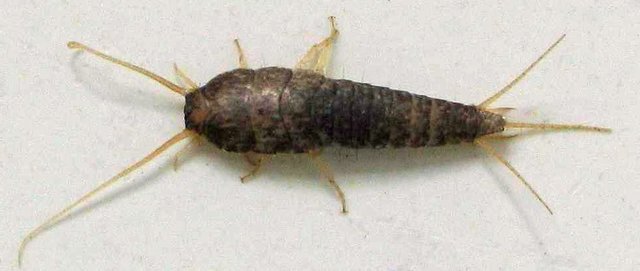Silverfish Bug
Recognizing the silverfish is the first step in figuring out whether you have any in your home. As mentioned earlier, the silverfish is usually silver, but not always. This bug is born white and can develop a red, brown, or near-black color as they grow. The silver color usually occurs after they have molted many times. The typical silverfish is anywhere from half an inch to one inch in length and they do not have wings. They tend to move with more of a wiggling movement rather than a crawling one, which also contributes to their fish-like appearance.

Now that you know what the silverfish looks like, it is important to understand the lifestyle of this creature. This proves to be a great help in knowing where to look for silverfish should you suspect an infestation. The silverfish bug is nocturnal, meaning they are most active during the night time. They require a moist environment, which means they are often found in basements, attics, bathrooms, and even garages. Closets near an air conditioning unit are also very common hide-outs for the silverfish.
The silverfish’s diet plays a large role in where he will spend most of his time. These bugs need a large amount of polysaccharides, which are complex carbohydrates and starches that can be found in sugar and coffee, but also in glue (especially the bindings of books), hair and dandruff particles, carpeting, wallpaper glue, clothes, and even paper. You may also notice them in airing cupboards or closets, as silverfish will also eat cotton, silk, and synthetic linens. It’s worth bearing in mind that silverfish can live for up to a year without eating; however, in times of starvation, they will even eat their own molted exoskeleton.
The silverfish’s life expectancy is anywhere from two to eight years, depending on its environment. Unfortunately, these creatures are similar to cockroaches in some ways: they are quick to reproduce and are so inactive during the day that you probably won’t ever see them about unless you stay up on a night time to catch them. In order to slow the spread of silverfish in your house, you need to treat the areas that are highest in moisture. Leaky pipes should be fixed and areas such as the attic and basement should be allowed to air out. Store cereals and similar foods in air-tight containers to eliminate as much of their food source as possible.
As the silverfish nest does expand in number quite fast, killing the odd silverfish here and there simply isn’t going to have a substantial effect on the nest. You need to try to find the nest itself where the majority of the silverfish live and eradicate them. There are baits available that can be sprinkled near the area you believe the silverfish inhabit, as well as aerosol sprays and outdoor insecticides. These, alone, may not be enough to handle a severe infestation, which may be best left up to a professional exterminator who can hunt them out and kill them more effectively.
Yes, silverfish are a nuisance and common pest, but they do not transmit diseases. Other than contaminating food and damaging wallpaper and other items, they do not usually prove a health threat to humans.